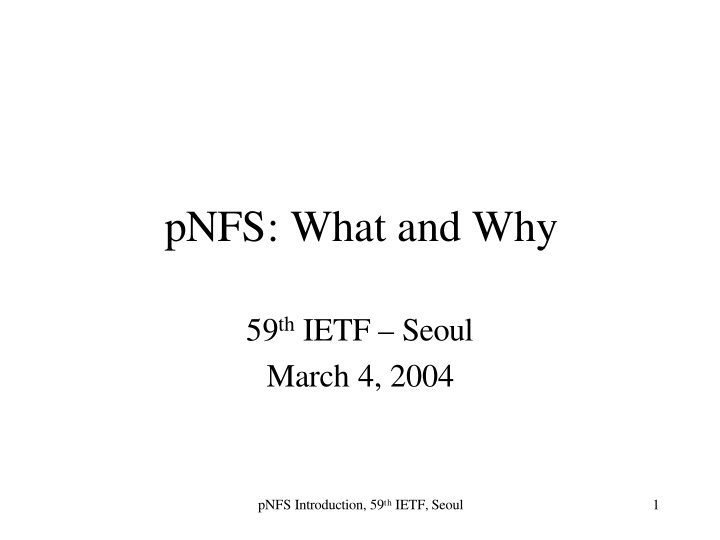



pNFS: What and Why 59 th IETF – Seoul March 4, 2004 pNFS Introduction, 59 th IETF, Seoul 1
pNFS - Parallel NFS • NFS Extensions for Parallel Storage • Workshop @ UMich CITI, December 2003 • Explored NFSv4 extensions to meet scalability needs, including: – Parallel NFS request routing / file virtualization – Extend block or object “layout” information to clients, enabling parallel direct access pNFS Introduction, 59 th IETF, Seoul 2
NFS Bandwidth Scalability • NFS limitations – Single NFS server has limited bandwidth & CPU – Multiple NFS servers are disjoint storage islands • Cluster computing driver – Through parallelism, cluster demand far outstrips traditional NFS server • Goal – Harness multiple storage servers to provide parallel access to single files and filesystems pNFS Introduction, 59 th IETF, Seoul 3
⇒ Now Goal Client Client Host Net Host Net N F N S v F 4 S v 4 NFS NFS Storage Net Storage Net Server Server Storage Servers Storage Servers • Now: requested data moves through NFS server • Goal: reply from NFS server enables parallel access to diverse storage servers (NFS, iSCSI, FC, …) pNFS Introduction, 59 th IETF, Seoul 4
Example Applications • High Performance Computing (HPC) clusters • Seismic data processing • Rendering farms • Data mining • Life Sciences • Compile farms • Electronic Design Automation pNFS Introduction, 59 th IETF, Seoul 5
Today’s Proprietary Solutions • SAN (IBM, EMC, Sun) and Object (IBM, HP, Panasas) file systems: – Allow clients to bypass metadata server to access data, but …. ⇒ Ε ach system is doing this differently with little or no standardization ⇒ Solutions have to provide kernel code in diverse OS’s • Scalable/cluster NFS servers: – Are standards compliant and facilitate scalable aggregate load, but …. ⇒ Don’t provide scalable/parallel bandwidth to a single file pNFS Introduction, 59 th IETF, Seoul 6
Why work on pNFS in the IETF? • Cluster/grid computing is a growing trend – HPC applications strong growth market – Data center technology gearing up for more cluster/grid use • Increasingly, storage data is transported in IETF protocols – NFS, iSCSI, NFS-RDMA • NFS is best candidate for a scalable bandwidth standard – Wide acceptance and use of NFS, integrated security – NFS interoperability track record – NFSv4 has mechanisms for clients to act more autonomously – NFSv4 minor versioning may suffice for incremental functionality • A standards venue for interoperable efforts – Strengthen NFS as most useful open standard file system – NFS and iSCSI symbiosis pNFS Introduction, 59 th IETF, Seoul 7
Community Interest • December 2003 U. Michigan workshop: Call for ideas – Whitepapers at www.citi.umich.edu/NEPS – U. Michigan CITI, EMC, IBM, Johns Hopkins Univ., Network Appliance, Panasas, Spinnaker Networks, Veritas, ZForce • Problem Statement Internet-Draft published – draft-gibson-pnfs-problem-statement-00.txt • Upcoming BOF at Usenix FAST ‘04 pNFS Introduction, 59 th IETF, Seoul 8
Summary • Bandwidth Scalability Problem: – Data intensive apps & clusters rapidly scaling up demand • Current state of the art: – Clustered NFS today inadequate to scale single file and file system bandwidth – Non-NFS file systems allow clients direct access to storage device, but are proprietary extensions • Desired solution: – NFSv4 extensions enabling clients to access data in parallel storage devices of multiple standard flavors pNFS Introduction, 59 th IETF, Seoul 9
Recommend
More recommend